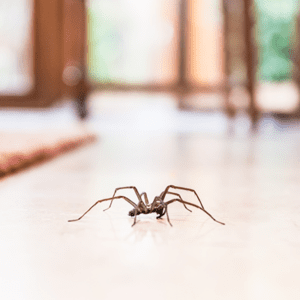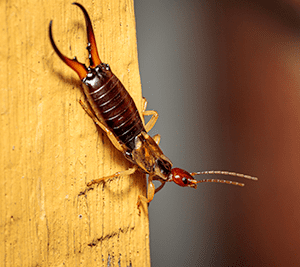Bugs are just a part of life, right? Occasionally, we have to swat a spider or chase a centipede, right? What if there was a way to enjoy your home without the constant worry of walking into a web or catching a darting centipede out of the corner of your eye? Well, there is! Top Lawn’s Top Guard pest control treatment guards your home against unwanted guests – all season long! Keep reading to discover a few of the most common invaders our Top Guard program keeps out.
Keep These Bugs At Bay With Perimeter Pest Control
What Is Perimeter Pest Control?
You’re probably familiar with aerosolized cans of bug killers like Raid. These products are effective, but they have their drawbacks. For one thing, they usually only cover one or two bugs – ants and roaches, for instance. For another thing, you have to spray it directly on the bugs. Hopefully, you’ve never had to deal with cockroaches in your home, but they are nimble. So what happens if you’ve got crawling insects, but they’re too quick or too well-hidden to spray directly? That’s where our perimeter pest control comes in. Using an odorless, colorless product, we will coat the exterior perimeter of your home from the ground up to three feet high along the walls of your home. After several hours, this product is dry and waterproof – yes, it lasts through the rain!
This invisible line of defense lasts for several weeks before you’ll need to reapply. Any crawling bug that crosses this line will die off. And it doesn’t matter whether the bug is an adult, larvae, or an egg. Perimeter pest control breaks the cycle of annoying bugs entering your home.
Bugs Affected By Perimeter Pest Control
Spiders
Most spiders you’ll encounter in Michigan are harmless, creepy, but harmless. There are a few instances of brown recluses in Michigan, but they aren’t as common as people think. That being said, it’s completely understandable that you don’t like finding them in your home. Even after you’ve killed it with the nearest shoe, it ruins your sense of calm and leaves you feeling uneasy. Many people have full-blown arachnophobia. Wherever you fall on the fear spectrum, we’re not here to judge. We want you to enjoy your home, which should start without worrying about walking into a spider web.
Cockroaches
Of all the insects on this list, cockroaches are by far the worst to have in your home. To make matters worse, roaches are one of the best survivors in the animal kingdom. They’ve been around for about 300 million years! Spiders are creepy, but they don’t bring the same health problems that roaches do. While they don’t bite or sting, they do what every living thing must: poop. And unlike humans, who keep things sanitary with toilets and plumbing systems, roaches will do their business wherever they please. All of that fecal matter builds up causes breathing problems, and ruins the air quality in your home. People with asthma are particularly vulnerable. Even folks without allergies can develop allergies to the presence of cockroaches. Once inside your home, roaches require an exterminator. However, you can take a proactive approach by investing in perimeter pest control.
Centipedes
Like spiders, centipedes are generally harmless, though indeed creepy – maybe even more so than spiders! In rare instances, centipedes have been known to bite, which can be comparable to a bee sting, but this isn’t common. Children and pets, who might try and mess with a centipede, are more likely to be bitten. House centipedes are more afraid of you than you are of them, but like spiders, no one likes spotting one lurking in the corner.
Ants
Both tiny pavement ants and larger, more destructive carpenter ants can be a significant pain in the butt. Pavement ants are so small that they can easily find their way through minor cracks in the walls, foundation, or seals. Once inside, they’ll take advantage of just about any food source, from the pet’s food bowl to microscopic crumbs on the floor. Carpenter ants tunnel through wooden structures like furniture, walls, and beams, causing damage that could cost you hundreds or thousands of dollars in repairs. Why not eliminate both with perimeter pest control?
Earwigs
On the creepy scale, earwigs fall somewhere around spider and centipede territory, and it’s not hard to see why! Their menacing pincers plus the old wives’ tale about them laying eggs in your ear is enough to disturb anyone! The good news: they don’t lay eggs in your ear. That’s a pretty big misconception. They will munch on your houseplants and hide in your bookshelves, however.
Silverfish
If you’ve never encountered these little guys, count yourself lucky. They’re named for the highly reflective, shiny silver exoskeleton they exhibit, resembling silver fish scales. Like roaches and centipedes, they scurry very quickly when disturbed. Most homeowners don’t know they have an infestation because these guys like to come out at night to chew on your paperwork and books. In addition to being nocturnal, silverfish are most likely found in attics and unused parts of the basement. So, there’s a good chance that you might have them in your home, but you aren’t aware.
Get Pest Control Near Milford
Some people might judge you for being afraid of spiders, but we sure won’t. Top Lawn understands how unsettling it is to find spiders, centipedes, and other gross bugs in your home. It leaves you with a sense of unease. Our Top Guard pest control program eliminates crawling insects before they have a chance to invade your home. To learn more or schedule a treatment, please call (248) 956-6022, or you can reach us through our contact form here.
Want to know more about keeping your home and garden pest-free? Check out our blog page!







